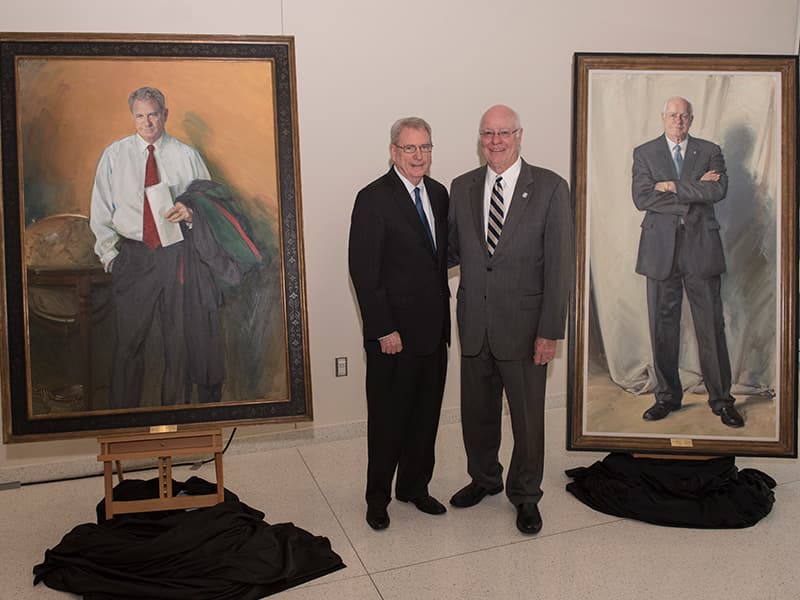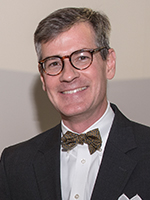Portraits unveiled for two big-picture leaders

The careers, lives and personalities of two former vice chancellors are distilled, framed and will soon be on display inside the building that might not exist without them: the new School of Medicine.
In a Thursday night gathering presided over by Dr. LouAnn Woodward, the friend and successor to the pair of honorees, the portraits of Dr. Dan Jones and Dr. James Keeton were unveiled before some 100 of their relatives, friends, colleagues and supporters, including former Gov. William Winter.

Award-winning oil portrait artist Jason Bouldin of Oxford, also known for his portrayals of civil rights figures Medgar Evers and his wife Myrlie Evers-Williams, created the Jones and Keeton paintings, which were paid for with donated funds.
Speaking before and after the ceremony, Bouldin said these latest works reflect the variations in temperament between the two men whose instincts and passions are, nonetheless, so much alike – a point Woodward made as she introduced them.
“They are very different individuals,” said Woodward, vice chancellor for health affairs and dean of the School of Medicine. “Different in style. Different in reaction times. Different in the kinds of jokes they tell.
“But similar in that they lead by the heart.”
Jones, a Morton native who grew up in Vicksburg, led Ole Miss as chancellor for six years, until 2015, after a stint as the Medical Center’s vice chancellor.
A 1975 School of Medicine alumnus and internal medicine specialist, Jones is acclaimed for his expertise in the areas of hypertension and obesity, serving at one time as national president of the American Heart Association, and currently holding the title of director of clinical and population science of the Mississippi Center for Obesity Research at UMMC.
He had returned to the Medical Center in 1992 as a faculty member after seeing patients as a private practice physician in Laurel.
Once Jones became vice chancellor, Woodward said, “everything changed.” He “cleaned up the place,” she said, broke new ground by hiring private physicians as faculty members and spearheaded an earnest effort to bring the Medical Center into the technological age.
“The walls shook a little bit,” Woodward said.
“He led a campaign to teach us who we are, and he got us all to believe that good enough was not good enough … . He got the fried chicken out of the cafeteria … . And the walls shook again. He changed who we are.”
Referring to Jones’ professional battles and his recent bout with cancer, Woodward said the defining word for him is “courage.”
“He is the most courageous person I have ever known.”
In Jones’ portrait, Bouldin gave a nod to his subject’s work as a former medical missionary: a world globe in the frame points to the Korean peninsula. Jones requested that detail, Bouldin said, to suggest “the global reach of the Medical Center.”
The artist posed Jones informally, holding his academic regalia on his arm, rather than wearing it – “I wanted to show … that he’s more than an academician and a physician. I wanted to show the person,” Bouldin said.
In his remarks, Jones spoke about his wife Lydia and their children. “The only legacy that matters to me when I leave this earth is these two children who love their God and their fellow man,” he said.
He then asked Woodward and Keeton to join him at the podium to show that “these three people can’t be separated.” Referring to Woodward, Jones said he looked forward to the time when her portrait would hang beside his and Keeton’s.
“When you look at my portrait,” Jones said to the audience, “I hope you will see a Mississippi country boy who came here … as a medical student and had his life transformed.”
Along the way, the Medical Center was transformed as well, a process sustained by his successors, including Keeton, now a professor emeritus who was a zealous cheerleader for building the new home for medical students.
A 1965 graduate of the original, 1955 school, he completed residencies in general surgery and urology, with further training in pediatric urology. But the Columbus native had considered a career with the YMCA instead.
“We’re glad the medical school thing worked out,” Woodward said. “If it hadn’t, I don’t think we would be in this building tonight.”
Noting that Keeton has the personality of a surgeon and a pilot – which he also is – Woodward said, “there is no doubt he has self-confidence.”
Bouldin’s goal was to capture that quality in his portrait of Keeton, whose figure’s intense gaze engages the viewer. The arms are crossed and the feet, Bouldin said, “are firmly planted on the ground.”
For her part, Woodward tried to sum up Keeton’s essence with this word: “Healer.” He is, she said, “a healer of physical and spiritual wounds.”
Breaking out Keeton’s favorite children’s book, “The Velveteen Rabbit,” Woodward read: “‘You become. It takes a long time … Generally by the time you are real, most of your hair has been loved off … (B)ut once you are real you can’t become unreal again. It lasts for always.”
Keeton, whose family includes his wife Jona, two children – including Dr. Mechelle Keeton, UMMC director of the Office of Physician Relations – and several grandchildren, joked about his portrait being taller than Jones’.
But his emotions took over when he observed that on this occasion he had one word for himself: “Humble.” Describing how he arrived on campus as a first-year student in 1961, “scared to death,” he added, “I’m humble that I’m standing in this building 56 years later.”

